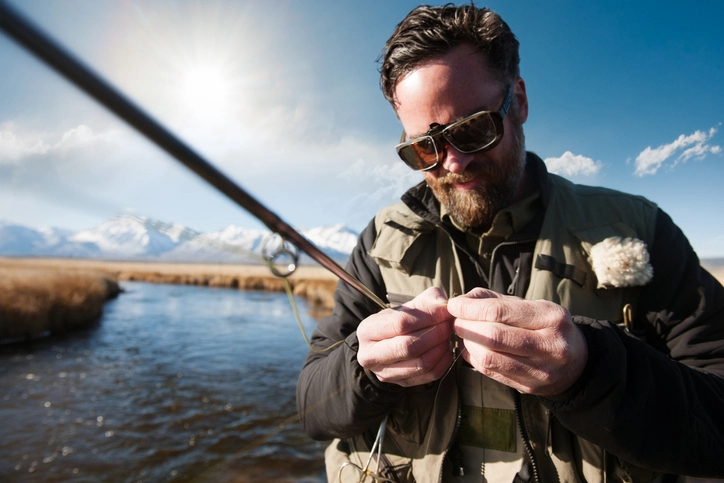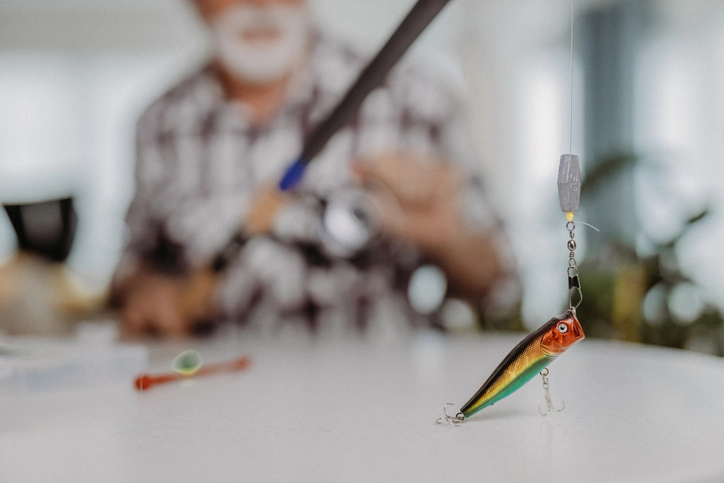How to Choose a Fishing Rod: The Complete Guide – Embark on a journey to discover the ideal fishing rod tailored to your needs, as we delve into the nuances of rod types, materials, and functionalities in this comprehensive guide.
HOW TO CHOOSE A FISHING ROD: BASICS
As beginners delve into the art of fishing, deciding on a fishing rod proves to be one of the most challenging tasks, alongside mastering the selection of a fishing reel. The extensive range of rods on the market can be overwhelming for new anglers. Questions arise about length, flexibility, and material – graphite, fiberglass, or a combination of both. The reassuring fact is that the process of choosing a fishing rod for beginners mirrors that of experienced anglers. Both groups must address the same crucial questions to find the ideal rod for their fishing endeavors.
What type of bait you will be using?
Armed with answers to these two questions, you can easily align fishing rod types with their intended uses. Whether opting for a novice or advanced fishing rod, comprehending the distinct characteristics that constitute this vital fishing gear facilitates selecting the appropriate rod for your catch.
When delving into the art of choosing a fishing rod, bear in mind that each rod strikes a balance between flexibility and strength. While robust rods handle heavier lures, they might lack sensitivity to subtle fish strikes or struggle with lightweight lines. On the other hand, lighter rods offer heightened sensitivity but may not possess the strength required for larger fish.
Rods vary in length, with shorter ones providing more power for battling fish, commonly used in trolling and big game fishing. Longer rods, like surf casting and fly rods, offer extended casting distances, reaching up to 14 feet. These longer rods can be disassembled into multiple pieces for convenient transport, with most rods up to 6 feet remaining one-piece.
SELECTING THE RIGHT ROD
To select the optimal fishing rod, first, determine your target and bait. Spinning rods suit lighter lures, ideal for beginners, while casting rods handle heavier artificial baits. Rods come in fiberglass or graphite, each with trade-offs: fiberglass is durable and cost-effective, while graphite is lighter and more sensitive but prone to damage. Hybrid rods blend both materials.
Comfort matters, so beginners often start with fiberglass. After choosing a style and material, match the rod’s weight to your lure and line size. Select a reel compatible with your chosen rod, and you’re ready to fish. Watch Capt. Diego Toiran for insights on choosing the best rod and reel combo, crucial for gear balance. Many stores offer pre-spooled rod/reel combos; consult your local tackle store for expert advice and the right equipment.
Casting Rods
Casting rods accommodate both spincasting and the widely favored baitcasting reels. Baitcasting gear excels with baits exceeding three-eighths ounces, offering heightened sensitivity and a diverse range of powers and actions to tailor your rod to specific baits. Explore “An Expert Guide to Choosing the Perfect Baitcasting Rod” for further insights.
Advantages
Baitcasting gear surpasses spinning setups in power, making it essential for specific scenarios. Employ baitcasting gear for frog, heavy jigs, or Texas rigs (over three-eighths ounces), and larger swimbaits (five inches and up). While mastering baitcasters requires practice, doing so unlocks the potential to fish a variety of baits and enhances your chances of securing a solid hookset.
Disadvantages
Baitcasters are less suitable for lighter baits. For baits under three-eighths ounces, opting for a spinning rod may be a better choice. Spinning rods handle lighter baits with improved efficiency and casting capability.
Spinning Rods
Many anglers, particularly beginners, favor spinning rods for their easy learning curve and mastery. Spinning rods shine in mimicking prey fish like minnows or shad. They come in various designs for specific scenarios, including deep-sea, ice, or surf fishing rods. Unlike casting rods, spinning rod handles may feature a single solid piece of cork instead of a split-grip design. “How to Choose a Spinning Rod” provides further details.
Advantages
Spinning rods lack a trigger for initiating the unspooling process; instead, the spool needs to be opened to cast the line. The effortless casting capability of spinning rods, coupled with their proficiency in handling lighter lures and baits, contributes to their widespread popularity among anglers.
Disadvantages
This style of rod and reel will struggle in situations where heavier lines and reel are in use. The rod may also struggle if the reel is used for fish that are larger than the gears are graded for.
Surf Rods
Saltwater anglers in the ocean utilize surf rods. These rods can be employed from the shore or extended to a sandbar, enhancing the ability to target larger fish effectively.
Advantages
Employing a surf rod offers enhanced quality and durability, resisting corrosion from the salt. Long rods, spanning nine to over fifteen feet, offer enhanced flexibility, letting anglers catch various fish and handle larger ones with medium power.
Disadvantages
Avoid casting surf rods all day; their heavier, longer build contrasts with other rods, making it impractical for extended use.Anglers who favor fishing from banks or piers along the coast primarily use these rods.
Fly Fishing Rods
Mastering fly rods demands practice due to their use of exceptionally light lures and lines. These rods exclusively pair with fly fishing reels and boast greater flexibility than their counterparts. This enhanced flexibility allows for precise whipping of the fishing line to any desired location. Fly fishing involves specific elements like super-light fishing lines, line control, and casting, requiring knowledge on techniques such as triggering a strike. Explore “Choosing a Fly Rod that Works for You” for further insights.
Advantages
Anglers can target various species by choosing from a range of lengths in fly fishing rods, each catering to specific strengths. From larger fish like steelhead or salmon down to panfish or micro-fish, fishermen have the flexibility to pursue their desired catch!
Disadvantages
Mastering fly fishing rods demands considerable skill and practice. While flies are less costly than some lures, the rods and reels are notably more expensive than those used in conventional fishing, such as spincasting reels. It’s crucial to note that fly fishing gear is not suitable for deep-water fishing; rather, it should be exclusively employed for shallow and top-water fishing.
Ice Fishing Rods
Including everyone, especially you northern ice fishermen, is essential for this article. Ice-fishing rods closely resemble typical spinning rods and are designed for small to medium-sized fish. Unlike regular spinning setups, in ice fishing, there’s no need to worry about casting, reducing the necessity for diverse gear.
Advantages
Ice rods, being smaller and more affordable, enable anglers to use multiple rods in various holes, enhancing the potential catch on each outing. Their compact size contributes to heightened sensitivity, even when using the smallest baits.
Disadvantages
Restrict the use of these rods to ice fishing only, as they are exceptionally compact and not designed for casting.
Telescopic Rods
Ideal for travel, telescopic rods are designed with convenient transport in mind. Another variant is the multi-piece rod, which can be disassembled into separate parts. Both types consist of multiple pieces that assemble into one complete rod when connected to the handle. Telescopic rods, in particular, fold into themselves and contract into the handle. When extended to full length, a telescopic rod exhibits minimal differences in flexibility and durability compared to rods made from a single solid blank.
Advantages
The primary benefit of a telescopic rod lies in its effortless transportation, making it ideal for hikers or individuals on the move, whether in a car or backpack. Another advantage is that telescopic rods maintain their design attributes comparable to solid rod counterparts. You can employ the same lures, lines, and tackle as you would on a non-telescopic rod. Therefore, if you aim to reach a secluded farm pond deep in the woods, requiring a one-mile hike, you have a lightweight option to conveniently pack in your backpack!
Disadvantages
A significant drawback of telescopic or multi-piece rods is the limited variety in finding a rod with the right action. Due to multiple components, these poles often lack sensitivity, making it challenging to detect bites on smaller fish when using an improperly sized rod. Another downside is that the various pieces comprising the rod create additional points where it can break, fail, or become stuck. Although these rods are deemed durable, maintaining proper care for your gear is also advised to keep them in optimal condition.
Ultra-Light Rods
As a young angler, your initial fishing rod was probably an ultra-light rod. While these rods come in various sizes, they are generally employed for smaller fish like panfish and trout. Designed with significant bend, these rods are intended for fighting fish with the rod tip raised rather than lowered. Ultra-light rods are commonly matched with spinning reels and spincast reels, as baitcasters, being more robust, are not suitable since casting isn’t the primary goal for an ultra-light rod.
Advantages
The primary advantage of an ultra-light rod lies in its capability to effectively catch and maintain connection with even the smallest fish. Panfish, with their tiny and delicate mouths, pose a challenge, but the lighter rod ensures a deeper hookset, harnessing the power once the fish is hooked. Due to its lightweight nature, the rod stays loaded regardless of the fish’s size. Ultra-light rods stand out for their lightweight construction and affordability. As an ideal choice for young anglers, it accommodates both spinning and spincast reels. Almost every ultra-light rod is also a fast-action rod, bending at the upper 25%, a concept explained further in the section below on rod action.
Disadvantages
An immediate drawback of an ultra-light rod is its unsuitability for battling game fish with the rod tip lowered. As previously mentioned, this rod is designed for fighting fish with the rod tip raised, posing durability concerns and making it susceptible to snapping if not handled carefully. The ultra-light rod sacrifices power, making it ill-suited for larger fish or lures exceeding one-sixteenth ounces. In such instances, upgrading to a medium-light rod would be a more appropriate choice.
What’s the right fishing rod length?
When selecting a new rod, one of the initial considerations is its length, ranging from 4 to 14 feet, encompassing stout close-quarter fishing rods to long casting poles. This broad spectrum comes with trade-offs, emphasizing the importance of aligning your rod choice with your fishing style. The impact of rod length on casting distance is significant, with longer rods allowing for extended casts but presenting challenges in maneuverability. Conversely, shorter rods offer greater control but limit casting distance. A 5–7′ rod excels in easy handling and power for underwater kayak fishing. For wading or using topwater lures, an 8+ foot rod is invaluable for exceptionally long casts.
For novice anglers, a consensus among most is that a 7′ fishing pole serves as a versatile and suitable choice.
Choose between fiberglass, graphite, or composite for your rod material. This decision greatly influences performance and impacts fishing success.
Final Thoughts on How to Choose a Fishing Rod
Embarking on the journey to master the skill of choosing the ideal fishing rod demands thoughtful consideration and expertise. This guide provides vital insights, from understanding rod materials to aligning them with your fishing technique. Armed with this knowledge, your fishing rod becomes a reliable companion on your quest.Through informed decisions reflecting your distinct preferences and fishing style, you can elevate your fishing experience to unprecedented levels. Wishing you a joyful fishing experience!


